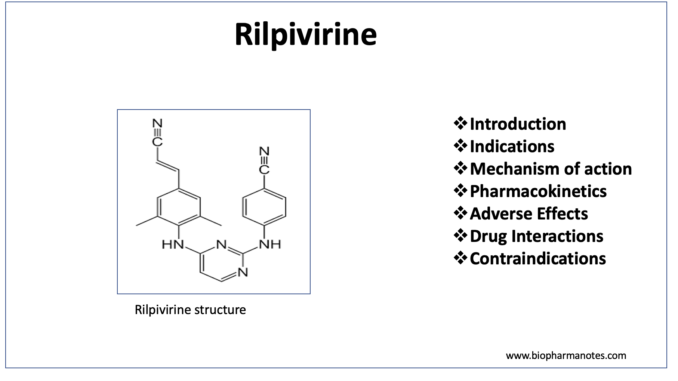
- Rilpivirine is drug belonging to class of NNRTIs (Non-Nucleoside Reverse Transcriptase Inhibitors). Chemically, it is diarylpyrimidine derivative. It is second drug from the new generation of NNRTIs.
- Rilpivirine was developed by Tilbotec, Inc. and was approved by FDA on May 2011.
Indications of rilpivirine
- Used in treatment of HIV infection in antiretroviral treatment- naïve patients and HIV-1 RNA count is £100,000 copies/mL and CD4+ count is ³ 200 cells/mm3. It is used in combination with other anti-retroviral agents.
- Its combination with dolutegravir as part of first complete treatment regimen was approved in 2017. This combination is used in HIV-1 infected patients with viral load < 50 copies/ml and are on stable regimen for 6 months and have not developed resistance to any of the two components of treatment regimen.
- Its combination with cabotegravir was approved by FDA on 21 January 2021 and is used in maintenance treatment in those patients with viral load < 50 copies/ml with their current ongoing antiretroviral treatment. There should be no known viral resistance to NNRTIs or INIs (integrase strand transfer inhibitors) before initiating this combination therapy.
Mechanism of action of rilpivirine
- It is non-competitive NNRTIs and binds to and inhibit HIV-1 reverse transcriptase. Reverse transcriptase (RT) is an important enzyme that control replication of the genetic materials of the HIV. It is used by HIV virus to convert its RNA to DNA (reverse transcription).
- It binds to allosteric hydrophobic site of RT, adjacent to active site and induce conformational change in enzyme resulting in enzyme inhibition. This results in inhibition of viral RNA transcription and leads to reduction of viral DNA production. It doesn’t require activation by cellular enzymes and doesn’t affect host cell DNA polymerases.
- It is thought to have higher potency than other older NNRTIs due to its internal confirmational flexibility (wiggling) and plasticity of its interaction with binding site (jiggling). This wiggling and jiggling reduce the chance of viral mutation and hence reduce risk of resistance.
Pharmacokinetics
- It is administered via oral or IM route. Peak plasma concentration is achieved within 4-5 hours of oral administration and within 3-4 hours of IM administration. Patients are recommended to take rilpivirine with food as taking it without food decreases its plasma level by around 40%.
- IM administration allows rilpivirine to bypass GI tract which may reduce risk of drug-drug interaction occurring in gut.
- It is highly protein bound (> 99%) and mostly binds to plasma protein, albumin. It is metabolized in liver by CYP3A4 and CYP3A5 enzymes.
- Majority of drug is eliminated via feces (85%) and around 6% is excreted via urine.
Adverse effects
- It can cause depressive disorders including altered mood, negative thoughts, major depression, and suicidal ideation. Other effects include skin rashes and hypersensitivity reactions, headache, hepatotoxicity, and insomnia.
- IM injection can cause pain or swelling at site of injection.
Drug Interaction
- Drugs which induce CYP3A enzymes like rifampin, phenytoin, carbamazepine, and dexamethasone may cause decrease in plasma concentration of rilpivirine and result in loss of its virologic response.
- Co-administration of rilpivirine with drugs like fluconazole, itraconazole and Posaconazole which inhibit CYP3A enzymes may cause increase in plasma concentration of rilpivirine.
Contraindications
- Contraindicated in patients with known hypersensitivity to rilpivirine.
- Its use with certain drugs which decreases its plasma concentration including phenytoin, rifampicin, carbamazepine, and St. John’s wort is contraindicated.
- Its use with proton pump inhibitors (PPIs) including omeprazole, lansoprazole is contraindicated as PPIs may increase gastric pH leading to decrease in plasma concentration of rilpivirine.
References
- https://go.drugbank.com/drugs/DB08864
- https://www.rxlist.com/edurant-drug.htm#warnings
- Ford N et al. Safety, efficacy, and pharmacokinetics of rilpivirine: systematic review with an emphasis on resource-limited settings. HIV AIDS (Auckl). 2011; 3: 35–44.
- Sharma M et al. Rilpivirine: a new non-nucleoside reverse transcriptase inhibitor. Journal of Antimicrobial Chemotherapy. 2013; 68(2): 250–256.
- Hodge D et al. Pharmacokinetics and Drug–Drug Interactions of Long-Acting Intramuscular Cabotegravir and Rilpivirine. Clinical Pharmacokinetics. 2021; 60: 835-853.